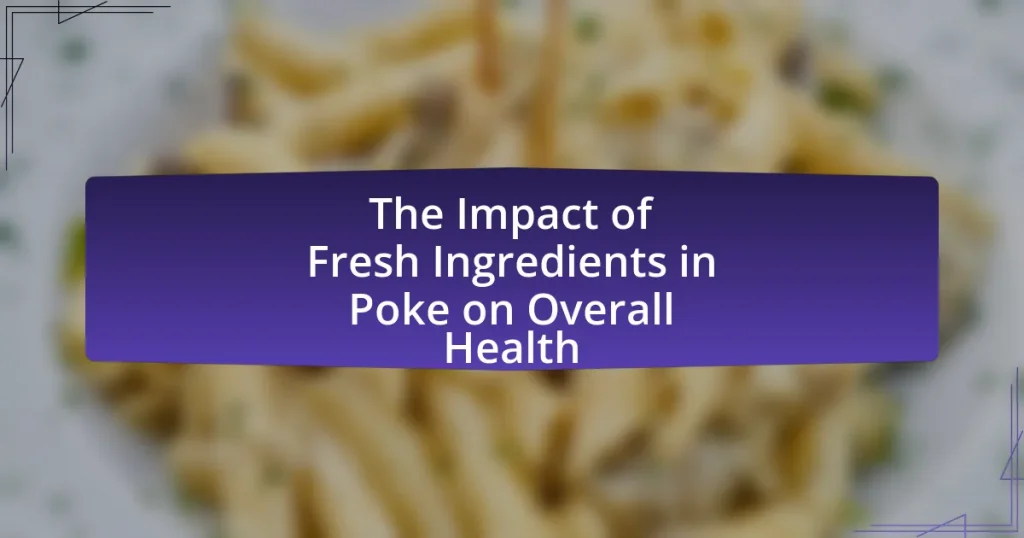Poke, a traditional Hawaiian dish, serves as a nutritious option for individuals aiming to manage their weight effectively. This article explores how poke bowls, typically low in calories and high in protein, can support weight management goals through their balanced ingredients, including fresh fish, vegetables, and whole grains. Key nutritional benefits of poke, such as enhanced satiety from protein and healthy fats, are discussed, along with strategies for customization and portion control to align with individual dietary needs. Additionally, the article highlights common pitfalls to avoid when consuming poke for weight loss and offers practical tips for incorporating this versatile dish into meal plans.

How Can Poke Support Weight Management Goals?
Poke can support weight management goals by providing a balanced meal option that is typically low in calories and high in protein. The ingredients in poke bowls, such as fresh fish, vegetables, and whole grains, contribute to satiety while offering essential nutrients. For instance, a standard poke bowl with salmon, brown rice, and assorted vegetables can contain around 500 calories, making it a filling yet manageable portion for those monitoring their caloric intake. Additionally, the high protein content from fish can enhance metabolism and promote muscle retention during weight loss, which is crucial for maintaining a healthy weight.
What are the nutritional benefits of poke for weight management?
Poke offers several nutritional benefits that support weight management, primarily due to its high protein content and low calorie density. The protein in poke, often derived from fish like tuna or salmon, promotes satiety, helping individuals feel full longer and reducing overall calorie intake. Additionally, poke bowls typically include vegetables and healthy fats, such as avocado, which provide essential nutrients while maintaining a balanced macronutrient profile. The combination of these elements can aid in weight loss efforts by encouraging healthier eating habits and portion control.
How does poke’s protein content aid in weight loss?
Poke’s protein content aids in weight loss by promoting satiety and preserving lean muscle mass. High-protein foods, such as poke, can increase feelings of fullness, which helps reduce overall calorie intake. Research indicates that protein has a higher thermic effect compared to fats and carbohydrates, meaning the body burns more calories digesting protein-rich foods. Additionally, maintaining muscle mass during weight loss is crucial, as muscle tissue burns more calories at rest than fat tissue. Therefore, the protein in poke supports weight management by enhancing satiety and aiding in muscle preservation.
What role do healthy fats in poke play in satiety?
Healthy fats in poke enhance satiety by promoting feelings of fullness and reducing hunger. These fats, such as those from avocado or fatty fish, slow down digestion and trigger the release of hormones that signal satisfaction to the brain. Research indicates that meals high in healthy fats can lead to increased satiety compared to low-fat meals, as evidenced by a study published in the American Journal of Clinical Nutrition, which found that dietary fats can influence appetite-regulating hormones like ghrelin and peptide YY. Thus, incorporating healthy fats in poke can effectively support weight management by helping individuals feel satisfied longer after eating.
Why is poke a good choice for a balanced diet?
Poke is a good choice for a balanced diet because it typically includes a variety of nutrient-dense ingredients such as fresh fish, vegetables, and whole grains. These components provide essential proteins, healthy fats, vitamins, and minerals that contribute to overall health. For instance, the fish in poke bowls is often rich in omega-3 fatty acids, which are beneficial for heart health, while the vegetables add fiber and antioxidants that support digestion and reduce inflammation. Additionally, poke can be customized to meet individual dietary needs, making it a versatile option for maintaining a balanced intake of macronutrients and micronutrients.
How does poke compare to other meal options in terms of calories?
Poke typically contains fewer calories compared to many other meal options, making it a favorable choice for weight management. A standard poke bowl, which includes ingredients like raw fish, vegetables, and rice, generally ranges from 300 to 600 calories, depending on portion sizes and toppings. In contrast, traditional fast food meals often exceed 800 calories, while many restaurant entrees can range from 600 to 1,200 calories. This lower calorie density in poke is attributed to its fresh ingredients and the ability to customize portions, allowing for healthier choices that align with weight management goals.
What are the benefits of incorporating fresh ingredients in poke?
Incorporating fresh ingredients in poke enhances nutritional value and flavor, contributing to overall health and weight management. Fresh ingredients, such as vegetables and high-quality fish, provide essential vitamins, minerals, and omega-3 fatty acids, which support metabolic processes and promote satiety. Research indicates that diets rich in fresh produce can lead to lower calorie intake and improved weight control, as evidenced by a study published in the Journal of Nutrition, which found that increased fruit and vegetable consumption is associated with reduced body weight and fat. Therefore, using fresh ingredients in poke not only elevates the dish’s taste but also aligns with weight management goals by offering a nutrient-dense, low-calorie meal option.
How can poke be customized to meet individual weight management needs?
Poke can be customized to meet individual weight management needs by adjusting the ingredients and portion sizes according to specific dietary goals. For instance, individuals aiming for weight loss can opt for a base of leafy greens instead of rice, choose lean protein options like tuna or tofu, and limit high-calorie toppings such as creamy sauces or fried onions. Research indicates that meal customization can lead to better adherence to dietary plans, as it allows individuals to tailor their meals to their caloric and nutritional requirements, thereby supporting weight management effectively.
What are the best toppings for a low-calorie poke bowl?
The best toppings for a low-calorie poke bowl include cucumber, seaweed salad, radishes, edamame, and avocado. These toppings are low in calories while providing essential nutrients. For instance, cucumber contains about 16 calories per cup and is hydrating, while seaweed salad is rich in iodine and low in calories, typically around 30 calories per serving. Radishes add crunch and are about 18 calories per cup, and edamame offers protein with approximately 120 calories per half-cup. Avocado, though higher in calories at around 160 calories per half, provides healthy fats that can promote satiety. These toppings collectively support weight management by offering flavor and nutrition without excessive calories.
How can portion control be applied when eating poke?
Portion control can be applied when eating poke by measuring the ingredients to ensure balanced servings. For instance, a standard serving of poke typically includes 3 to 4 ounces of protein, 1 cup of vegetables, and a small amount of rice or base, which helps maintain appropriate calorie intake. Research indicates that controlling portion sizes can lead to reduced overall calorie consumption, thereby supporting weight management goals. By adhering to these measurements, individuals can enjoy poke while effectively managing their dietary intake.

What factors contribute to the effectiveness of poke in weight management?
Poke is effective in weight management primarily due to its high protein content, low calorie density, and customizable ingredients. The high protein content in poke bowls, often derived from fish like tuna or salmon, promotes satiety, which can reduce overall calorie intake. Additionally, poke typically includes fresh vegetables and whole grains, which are nutrient-dense and low in calories, further supporting weight management. Customization allows individuals to tailor their meals to their dietary needs, enabling better adherence to weight loss goals. Studies indicate that high-protein diets can enhance weight loss and maintenance, reinforcing the effectiveness of poke in this context.
How does the preparation method of poke influence its health benefits?
The preparation method of poke significantly influences its health benefits by determining the nutritional content and caloric intake. For instance, using fresh, high-quality fish and incorporating a variety of vegetables enhances the dish’s omega-3 fatty acids, vitamins, and minerals, which are essential for overall health. Additionally, preparation methods that avoid excessive sauces or high-calorie toppings help maintain a lower calorie count, making poke a favorable option for weight management. Studies indicate that meals rich in lean proteins and vegetables can promote satiety and reduce overall caloric consumption, supporting weight loss efforts.
What are the differences between traditional and modern poke recipes?
Traditional poke recipes primarily feature raw fish, typically ahi tuna, marinated in a simple mixture of soy sauce, sesame oil, and green onions, emphasizing fresh, high-quality ingredients. In contrast, modern poke recipes often incorporate a wider variety of proteins, including cooked seafood, tofu, and even non-seafood options, along with diverse toppings such as avocado, mango, and various sauces, reflecting a fusion of culinary influences. This evolution allows for greater customization and caters to diverse dietary preferences, making poke more accessible while still maintaining its roots in Hawaiian cuisine.
How can cooking techniques affect the nutritional value of poke?
Cooking techniques can significantly affect the nutritional value of poke by altering the levels of nutrients and the overall healthiness of the dish. For instance, methods such as steaming or poaching can preserve more vitamins and minerals compared to frying, which can add unhealthy fats and calories. Research indicates that cooking methods that involve high temperatures, like grilling or frying, can lead to nutrient loss, particularly of heat-sensitive vitamins such as vitamin C and certain B vitamins. Additionally, the use of marinades or sauces during cooking can introduce extra sugars and sodium, impacting the overall nutritional profile. Therefore, the choice of cooking technique directly influences the nutrient retention and health benefits of poke, making it essential to select methods that enhance rather than diminish its nutritional value.
What role does portion size play in enjoying poke while managing weight?
Portion size plays a crucial role in enjoying poke while managing weight by allowing individuals to control calorie intake without sacrificing flavor or satisfaction. By choosing smaller portions, one can enjoy the diverse ingredients and flavors of poke while keeping overall caloric consumption in check. Research indicates that smaller portion sizes can lead to reduced energy intake, which is essential for weight management. A study published in the American Journal of Clinical Nutrition found that participants who consumed smaller portions of meals reported lower overall calorie intake and maintained better weight control compared to those who consumed larger portions. Thus, mindful portion sizing in poke can effectively support weight management goals while still providing a pleasurable dining experience.
How can one determine the right portion size for poke bowls?
To determine the right portion size for poke bowls, one should consider a balanced ratio of protein, carbohydrates, and vegetables, typically aiming for about 4-6 ounces of protein, 1-2 cups of vegetables, and ½-1 cup of rice or base. This guideline aligns with dietary recommendations that suggest a balanced plate for optimal nutrition. Research indicates that portion control is crucial for weight management, as studies show that larger portions can lead to increased caloric intake, which may hinder weight loss efforts. Therefore, adhering to these portion sizes can help maintain a healthy diet while enjoying poke bowls.
What strategies can help in avoiding overeating poke?
To avoid overeating poke, one effective strategy is to pre-portion servings before eating. This method helps control the amount consumed and prevents mindless eating. Research indicates that individuals who serve themselves smaller portions tend to consume fewer calories overall, which supports weight management goals. Additionally, focusing on eating slowly and mindfully can enhance satiety signals, allowing individuals to recognize when they are full, further reducing the likelihood of overeating.

How can individuals incorporate poke into their weight management plans?
Individuals can incorporate poke into their weight management plans by selecting poke bowls that emphasize lean proteins, fresh vegetables, and healthy fats while controlling portion sizes. Poke typically features ingredients like raw fish, which is low in calories and high in protein, aiding in satiety and muscle maintenance. Additionally, choosing brown rice or leafy greens as a base instead of white rice can enhance fiber intake, promoting digestive health and fullness. Research indicates that high-protein diets can support weight loss by increasing metabolic rate and reducing appetite, making poke a suitable option for those aiming to manage their weight effectively.
What are some practical tips for including poke in a meal plan?
To include poke in a meal plan, focus on incorporating it as a protein-rich option that can replace higher-calorie ingredients. Poke bowls typically consist of a base like brown rice or quinoa, topped with fresh fish, vegetables, and healthy fats such as avocado. This combination not only provides essential nutrients but also promotes satiety, which can aid in weight management. Research indicates that meals high in protein can increase feelings of fullness and reduce overall calorie intake throughout the day. Additionally, preparing poke at home allows for control over portion sizes and ingredient quality, further supporting weight management goals.
How can meal prepping with poke support weight management goals?
Meal prepping with poke can support weight management goals by providing balanced, portion-controlled meals that are rich in nutrients and low in calories. Poke bowls typically consist of fresh fish, vegetables, and whole grains, which contribute to a high protein and fiber intake, promoting satiety and reducing overall calorie consumption. Research indicates that high-protein diets can enhance weight loss and maintenance by increasing feelings of fullness and reducing hunger (Westerterp-Plantenga et al., 2009, “Dietary Protein and Weight Management”). By preparing poke meals in advance, individuals can avoid impulsive eating and ensure they have healthy options readily available, further aiding in weight management efforts.
What are some easy poke recipes for weight management?
Easy poke recipes for weight management include a base of brown rice or quinoa topped with lean proteins like tuna or salmon, combined with plenty of fresh vegetables such as cucumber, avocado, and seaweed. For instance, a simple poke bowl can consist of diced raw tuna, edamame, shredded carrots, and a light soy sauce or sesame dressing, providing a balanced meal low in calories but high in nutrients. These ingredients are low in saturated fats and high in omega-3 fatty acids, which can support heart health and weight management. Additionally, using a variety of colorful vegetables increases fiber intake, promoting satiety and aiding in weight control.
What are common mistakes to avoid when eating poke for weight loss?
Common mistakes to avoid when eating poke for weight loss include choosing high-calorie toppings, overloading on sauces, and neglecting portion control. High-calorie toppings like avocado and fried onions can significantly increase the calorie count, undermining weight loss efforts. Overloading on sauces, especially those that are creamy or sugary, can add unnecessary calories and fats. Additionally, neglecting portion control can lead to consuming more calories than intended, as poke bowls can be deceptively large. By being mindful of these factors, individuals can better align their poke consumption with their weight loss goals.
How can one avoid high-calorie toppings in poke bowls?
To avoid high-calorie toppings in poke bowls, one should opt for lighter options such as fresh vegetables, seaweed, and low-calorie sauces. These alternatives provide flavor and texture without significantly increasing calorie content. For instance, substituting creamy dressings with vinegar-based options can reduce calories while still enhancing taste. Additionally, choosing toppings like cucumber, radish, or edamame instead of fried or sugary items can help maintain a lower calorie count. Studies indicate that incorporating more vegetables in meals can lead to better weight management outcomes, supporting the goal of healthier eating.
What should be considered when choosing poke from a restaurant menu?
When choosing poke from a restaurant menu, consider the ingredients and their nutritional value. Selecting poke with fresh, high-quality fish, such as tuna or salmon, provides essential omega-3 fatty acids, which are beneficial for heart health and can aid in weight management. Additionally, opting for a base of greens or brown rice instead of white rice can enhance fiber intake, promoting satiety. Toppings like avocado and seaweed add healthy fats and nutrients, while sauces should be chosen carefully to avoid excess calories and sugars. Research indicates that meals high in protein and fiber can support weight management by increasing feelings of fullness (Slavin, J. L., 2005, “Why Whole Grains Are Important”).
What are the best practices for enjoying poke while staying on track?
To enjoy poke while staying on track with weight management goals, focus on selecting lean proteins, controlling portion sizes, and incorporating plenty of vegetables. Lean proteins such as tuna or salmon provide essential nutrients without excessive calories. Keeping portion sizes in check, ideally around one cup of poke, helps manage caloric intake. Additionally, filling half the bowl with vegetables like seaweed, cucumber, or avocado adds fiber and nutrients, promoting satiety without adding significant calories. These practices align with dietary guidelines that emphasize balanced meals for effective weight management.



